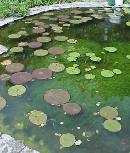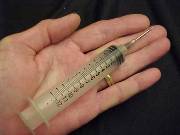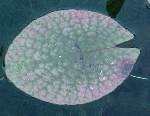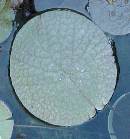
Weakly Weekly
(Or everything you didn't really want to know
about feeding Victoria and were afraid to ask)
A familiar term in the orchid world is "weakly weekly", feeding dilute amounts of nutrients frequently, and we fully subscribe to the practice for Victorias. Because, in our sand, nutrients either go directly to the plants or quickly dissipate in to the water, it works for us and has helped us devise methods that work with babies, less tolerant of excess or inappropriate nutrients than adults.
We have also devised a nutrient package that works extremely well for all Victorias in all reported soils and growing conditions. We call it the "Cocktail". Each ingredient is essential and substitutes do not work. Sources for obtaining them can be found here -- Sources For Cocktail Ingredients. We have tested numerous biostimulant products and have found that "Roots" works best in the Cocktail.
 From
this point on, we make all measurements and applications of the
cocktail with a 10cc or 12cc syringe and 16 gauge needle available
from most feed stores, some veterinarians or some pharmacies.
The cocktail is injected into the soil (sand) in the cup
(pot) with the needle and syringe.
From
this point on, we make all measurements and applications of the
cocktail with a 10cc or 12cc syringe and 16 gauge needle available
from most feed stores, some veterinarians or some pharmacies.
The cocktail is injected into the soil (sand) in the cup
(pot) with the needle and syringe.
From sprout to first floating leaf, any fertilizer at all seems to damage all Victoria seedlings. During this phase, the baby is entirely dependent on the endosperm in the seed to feed it. As soon as that first floating leaf reaches the surface of the water, the seedling needs something from the grower. Too much something can burn it and too little will lead to smaller subsequent leaves and eventual death. This is why we stress EXACT proportions of our cocktail and an EXACT schedule of feeding.
When the seedlings have filiform leaf, two hastate leaves and some roots, we are ready to plant. We put a tablespoon of Canadian peat in the bottom of the 3 ounce starter cups in which we have poked small holes. We fill the cups with once-washed beach sand and plant the seedlings. We mention this here because peat has made, in combination with the fertilizing described below, a huge difference in seedling survival.
|
5 cc Basic Roots Cocktail This can be mixed in advance and stored in a sealed container. |
 Rates - In 3 ounce cups (with holes poked in
the bottom and 1 teaspoon of peat) from first floating leaf to
boost (third or fourth floating leaf) in pot size, 1/2-1cc weekly
based on leaf size and general health.
Rates - In 3 ounce cups (with holes poked in
the bottom and 1 teaspoon of peat) from first floating leaf to
boost (third or fourth floating leaf) in pot size, 1/2-1cc weekly
based on leaf size and general health.
In 8-9 ounce cups (with holes poked in the bottom and 1 tablespoon peat) or 4" pots with peat, 1-3cc weekly based on leaf size and general health. When in doubt, choose less rather than more. Even 'Longwood Hybrid' will burn if overfed at this stage. If burn occurs give less or no cocktail the next week.
In 6" pots, the first week after boosting, we give 3cc of the Baby Cocktail, increasing that gradually to 30cc as the plants increase in size. It is possible at this stage to feed a less dilute version of the Cocktail mixed as follows:
|
10 cc Basic Roots Cocktail This can be mixed in advance and stored in a sealed container. |
In pots larger than 6" and for installed plants, we begin feeding a combination of Pondtabbs and undiluted Cocktail weekly, the amount based on pad surface area in square inches measured just before feeding. The formula we have plugged into our fertilizer spreadsheet is --
The total amounts can be slightly higher in water 80-90F and slightly lower when water is below 70F. In soils more fertile than sand, the ratio of Pondtabbs to Cocktail can be increased though the total amount of nutrients should remain the same. Though it has not yet been tested, it is possible that Pondtabbs Plus used without Cocktail may provide adequate and appropriate nutrition for adults in some soils.
Both species are, at all the above stages, slower growing than the hybrids. V. amazonica should be given slightly less fertilizer than others at the baby stage. V. cruziana performs best on the "Roots" Cocktail at all stages.
PLEASE REMEMBER YOU CAN ALWAYS GIVE MORE FERTILIZER NEXT WEEK BUT YOU CAN'T TAKE BACK WHAT YOU'VE ALREADY GIVEN WHEN YOUR PLANT IS BURNING.
As a side note, many aquatics that can be difficult to grow, including Australian waterlilies in the subgenus Anecphya, benefit greatly from regular feeding with PondTabbs and the Cocktail.
|
|
|


